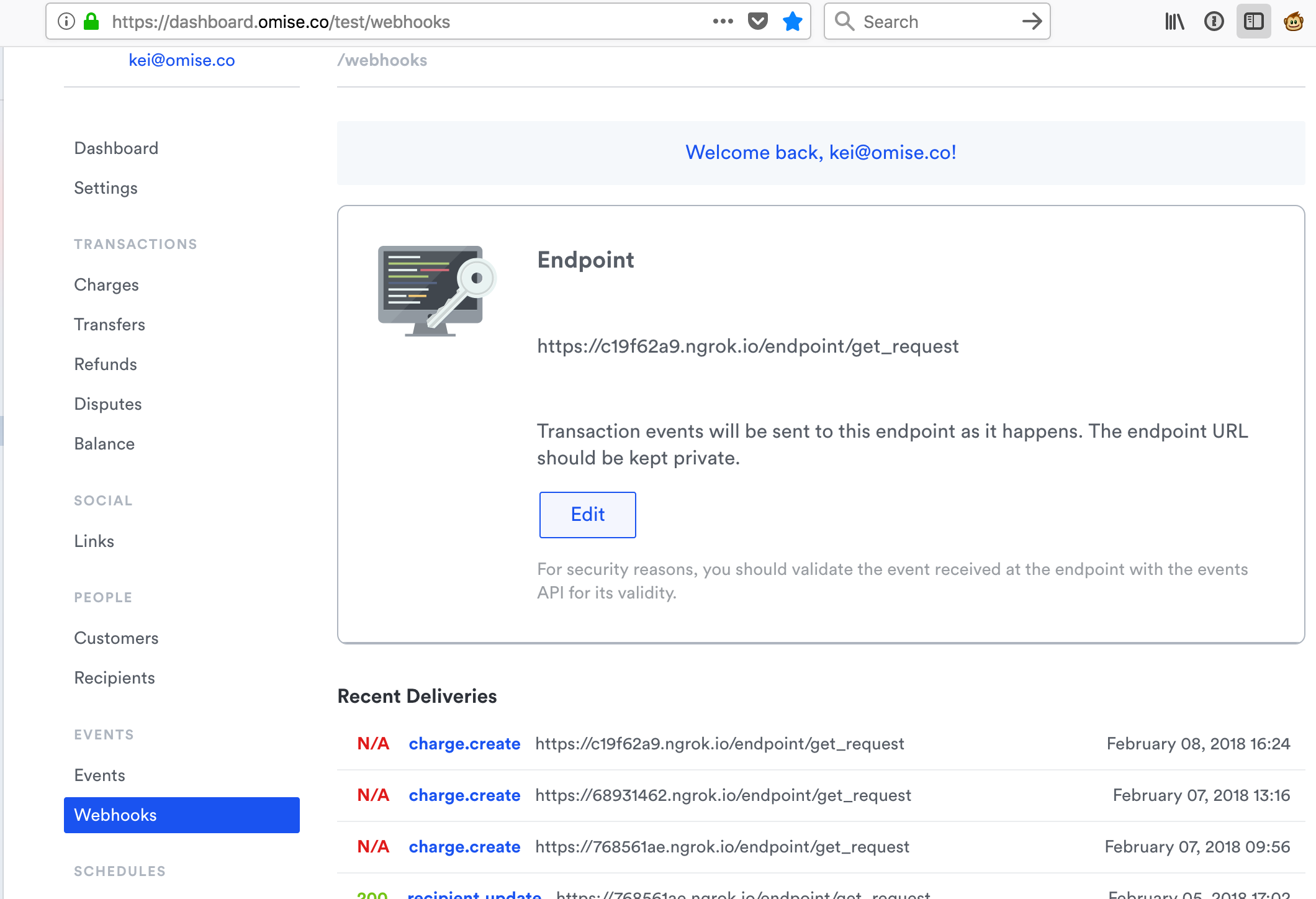こんにちは。Keiです。
今回は、Omise Webhookのつかいかたについてざっくりと説明したいと思います。
Omise Webhookとは、あなたが加盟店であると定義したときに、あなたのAPIの操作の結果を、あなたのサイトにとばしてくれるサービスです。
HTTPS サーバを立てる
OmiseのWebhookはHTTPをサポートしていないため、TLS証明書を取得して、HTTPSのサーバーを立てる必要があります。(立て方の詳細はこの記事では割愛します)
エンドポイントを作る
OmiseのサーバーはあなたのWebサーバーにHash形式のデータを、POSTリクエストとして投げるので、これを受けるためのエンドポイントを作ります。この際にやらなくてはならないことは、
- エンドポイントのページファイルの作成及び配置
- ルーティングの設定
です。例えばRailsでやる場合、
endpointコントローラにget_requestという、webhookを受け取るアクションを定義するとして、
$ bin/rails generate controller endpoint get_request
そうすると、 config/routes.rb は、
Rails.application.routes.draw do
get 'endpoint/index'
scope "/endpoint" do
post :get_request, to: "endpoint#get_request"
get :index, to: "endpoint#index"
end
end
こんな感じになります。
で、実際のコントローラはどうなっているかというと、
class EndpointController < ApplicationController
skip_before_action :verify_authenticity_token
require 'io/console'
require 'mail'
require 'slack-notifier'
def index
end
#
# take the incoming POST request from Omise webhook server
# and parse|filter is, then send to Email|Slack notification
#
def get_request
send_email
send_slack
end
ここまでがpublicメソッドです。 get_requestには、今回の例では send_mail(メール送信)と send_slack(スラック送信)を実装しています。
ちなみに、Omiseから送られてきたWebhookの中身は、上記configのルーティングのようにすれば、paramsというやつで取得することができます。なので、以下のようにしたりしてパラメータからメッセージを作ることが可能です。
def build_notification_content
data = params["data"] || {}
refunds = data["refunds"] || {}
card = data["card"] || {}
params_filtered = {
key: params['key'], # such as: charge.update etc..
id: params['id'],
mode: params['livemode'] ? 'live' : 'test',
created: params['created'],
charge_id: data['id'],
charge_amount: data['amount'],
currency: data['currency'],
description: data['description'],
status: data['status'],
capture: data['capture'],
authorized: data['authorized'],
reversed: data['reversed'],
paid: data['paid'],
transaction: data['transaction'],
source_of_fund: data['source_of_fund'],
refunded: data['refunded'],
refunds_total: refunds['total'],
refunds_location: refunds['location'],
from: data['from'],
to: data['to'],
return_uri: params['return_uri'],
offsite: params['offsite'],
offline: params['offline'],
reference: params['reference'],
authorize_uri: params['authorize_uri'],
failure_code: params['failure_code'],
failure_message: params['failure_message'],
card_id: card['id'],
card_last_digits: card['last_digits'],
card_brand: card['brand'],
card_expiration_month: card['expiration_month'],
card_expiration_year: card['expiration_year'],
card_finger_print: card['finger_print'],
card_name: card['name'],
card_cvv: card['security_code_check'],
customer: params['cust_test_5ar6mkaz88ltyem88ve'],
event_id: params['event_id'],
transaction: params['transaction'],
}
params_filtered
.select{ |k, v| v }
.inject(""){|k, (c, v)| "#{k}\n[#{c}] #{v}" }
end
エンドポイントをOmiseに登録する。
さて、受け取り口ができたところで、そのページをOmiseに登録しましょう!
OmiseのダッシュボードのWebhookに行き、上の方のパネルのエンドポイントの編集をクリックします。

そして、ここに必要なエンドポイントを登録します。

これでオーケーです。
メール送信
さて、これを使って、メール送信をする場合 rubyにはmailというgemがあります。これを使えばほぼほぼ1ファイルでメールを実装することが可能です。
#
# Email Generation/Sending Section
#
# XXX might have to be located in another backend class
#
def send_email
sender_email_address = Rails.application.secrets.sender_email_address
target_addresses = Rails.application.secrets.default_target_addresses.split(",")
pass = Rails.application.secrets.email_pass
user_name = /^[^@]+/.match(sender_email_address).to_s
Mail.defaults do
delivery_method :smtp, {
address: "smtp.gmail.com",
port: 587,
domain: "example.com", # this does not need to be changed
user_name: user_name,
password: pass,
authentication: 'plain',
enable_starttls_auto: true
}
end
content = build_notification_content
title = "#{params['key']}: "
#
# If dispatching of destination, email header, or email content
# needed you can use incoming parameters and define condition clause
# with these.
# The following example sets the specific email title if
# the status is success.
#
if params["data"]["status"] == "successful"
title += "success on #{params['data']['id']}"
end
target_addresses.each do |recipient_email_address|
mail = build_mail(sender_email_address, recipient_email_address, title, content)
mail.charset = "UTF-8"
mail.content_transfer_encoding = "8bit"
mail.deliver!
end
rescue Net::SMTPAuthenticationError
raise("\nEmailAddress/Password is incorrect: #{sender_email_address}\n\n")
end
def build_mail(sender_email_address, recipient_email_address, _subject, _body)
Mail.new do
from sender_email_address
to recipient_email_address
subject _subject
body _body
end
end
end
Slack送信
Slackにはslack-notifierというのがあるので、これを使用します。(まず、SlackのwebhookのURLを取得する必要がありますが、これはSlackのサイトから簡単にできます)
require "slack-notifier"
def send_slack
url = Rails.application.secrets.webhook_url
notifier = Slack::Notifier.new(url)
message = build_notification_content
notifier.ping "==========================\n#{message}\n"
end
などなど、です。
なお、上記のソースコードはこちらから参照可能なので、興味があったらみてください。
また、わからないことなどあったら kei@omise.co までどうぞ。